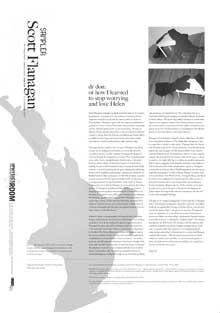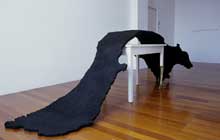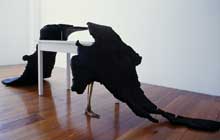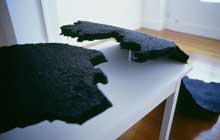 |
|||||||||
|
|
| ...GALLERY EXHIBITS 2004 | ...Scott Flanagan | |||||||||||||
|
Dr Don: or how I learned to stop worrying and love Helen Scott Flanagan’s installation eruditely evokes his desire to “re-conquest propaganda”. It manifests his observations of and research into corporate controlled media and the current political climate in New Zealand. Flanagan in past work has employed performative gestures to convey a sense of dislocation, fragmentation of identity and the obstacles generated by social conditioning. Through an alliance of trans-national artists and art work, he curated an exhibition entitled Looking After My Friends and Influencing People (2003), an exhibition that ‘bypassed local networks and artistic canons’ and aimed to reinvest artistic practice with a political edge.1 Here again he has created a mise en scene. Flanagan’s unyielding critique on the stifling of individuality in society, the absurdity of political theatrics and the stupidity of propaganda doggerel is conveyed through the construction of a map of New Zealand propped atop a table. Such a straightforward, visual premise is deceptive however, when a degree of subversive humour is revealed in its making. dr don: or how I learned to stop worrying and love Helen connotes a level of political paranoia, game playing and subterfuge between New Zealand’s parliamentary protagonists. Elements of Stanley Kubrick’s filmic masterpiece of 1964 with its insane, impotent general convinced that the “precious bodily fluids” of Americans are being poisoned through fluoridation of the water by Russian Communists, are evoked by Flanagan to create another, alternative parody. In Flanagan’s installation Helen and Don are recast as doppelgangers among their own government of loons. This is an uncanny set up given recent public spats centring on race relations, the foreshore, genetic engineering and New Zealand’s status as a nuclear free country. As the American President, played by Peter Sellars in Kubrick’s movie, upon witnessing the childish antics of a Russian ambassador and American war general exclaims: “you can’t fight in here, it’s the War Room!” Kubrick’s elegant cinematography and textured black and white imagery, such as the fly over shots from a B52 bomber as it advances upon the U. S. S. R, are evoked through the map’s construction. Flanagan’s bitumen map of New Zealand could be a visual from a low tech radar screen circa 1964 or a detail from the ‘Big Board’ in the film’s War Room. Bitumen, a residue oil substance used in the roading industry is here resonant with associated implications of globalisation and exploitation of land and labour. 2 Its surface tackiness and dull bottomless blackness hoisted upon a fragile white desk, with one table ‘leg’ being that of a human’s bones, accentuates the imbalance of power in New Zealand with the ‘foot’ of power being a load bearing folly. The table, an essential accessory for educational purposes, and leg/foot, imply a sense of both the perishing and persistence of colonial history. The artist states that he is “dissatisfied with being the progeny of colonialist attitudes destructive to Maori culture”. The human leg (white?) attached to a white table, which in turn supports a (black) New Zealand, further connotes the current unease of racial identification within a divided country played out in New Zealand politics, as exemplified by Don Brash’s speech at the Orewa Rotary Club earlier this year. Flanagan’s New Zealand is shaped to form a Bell Curve. The Bell- Curve hypothesis written in 1994, claims that intelligence is tied to a gene that is related to skin colour. 3 Flanagan links this fascist and ridiculous claim to the current dominance of intellectual group superiority, class struggles and the fissures within Treaty debates. And like Kubrick’s movie, his installation is akin to an ironic suspense comedy. The potential for the bitumen, bell-curved map to collapse on itself, or the fragile table ‘leg’ to crumble, are possible catastrophes held in tension, suggestive of an inevitable doomsday comic implosion. This is echoed further when consideration is given to Flanagan’s other points of reference; that of Fordist hegemony and subsequent Capitalist propaganda,4 as well as Aldous Huxley’s insidious work of literature Brave New World (1932). During Fordism, craft based production was supplanted by mass production, with security of jobs, powerful mass unions and strong nation states making up Fordist Capitalism. However by the 1970s, a decline in economic growth, an increase in the price of oil and the development of global culture and huge multi-national corporations saw the end of this institutionalised ideology. The urge to “re-conquest propaganda”, is led in part by, as Flanagan states: “the emphatic denigration of popular (corporate controlled) media by the agenda film making of Michael Moore and advocacy journalism of John Pilger”. He goes on to say that: “Propaganda relies on compliance. It is one of the few points of commercial transaction within our relationship to propaganda. Institutionalised norms offer us leisure in exchange for compliant belief ”. The dangers described by the Bell Curve New Zealand, with its contours and coastlines, prejudices and power struggles, perhaps has no ‘recall code’ or panacea other than resistance. As a safeguard against conservatism entrenched in Democracy, it is a tactic that Flanagan emphatically employs. Thus the map’s precariousness as a hand crafted yet sinister ‘paved paradise’, is a prescient warning for us about the dubiousness of false national stability and complacency inherent within the ‘status quo’. Jenifer Hay Scott Flanagan was born in 1970. Based in Christchurch, Flanagan has been exhibiting regularly throughout New Zealand since 1996, he has also been included in group exhibitions in Australia and the United Arab Emirates. Images © Scott Flanagan. Text © The Physics Room. Photo credit: Rory Kinahan 1. See: Looking After My Friends And Influencing People, curated by Scott Flanagan, text, Stephanie Oberg. CoCA 21st May - 8th June 2003, 2. Dr Brash has also spoken of the need to improve the roads in New Zealand - that “…highways generate growth” and “…if New Zealand is to achieve the kind of growth to which we all aspire, it is imperative that Auckland is freed from the shackles which currently impede its growth” . ‘Roading Now, 21st May 2004, an address to the Auckland Chamber of Commerce Hyatt Regency Hotel, Auckland. 3. The Bell Curve Richard J. Hernstein and Charles Murray, New York Free Press, 1994. 4. So called after Henry Ford (1863-1947) and the continuous growth and profits experienced in the industrialized world from the 1930s to the early 1970s. Cold War paranoia played a crucial role in political stabilization of Fordist institutions in the U. S. Scott Flanagan
View Dr Don: or how I learned to stop worrying and love Helen as a PDF
|
|||||||||||||





